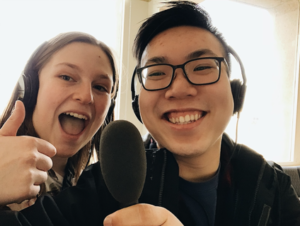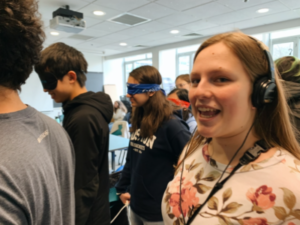12 Jun 2020 An Unforgettable First Day

I’m Felix Li and I’m a Freshman majoring in 6-3 (Computer Science) and minoring in CMS (Comparative Media Studies)!
With animal print blindfolds on and hands gripped onto a piece of rope, we were guided by our professor Ari Epstein across the MIT campus. We were left with two senses: sound and touch. The tension of the rope and the voices of our professor and undergraduate teaching fellows (utfs) were the only things guiding us across campus. I felt the tug of the rope, unfamiliar handrails, unseen stares of strangers, but more important than what I felt was what I heard.
Ari said to pay attention to every single sound we hear: listen to how the atmosphere of the room changes, how the inside and outside sound different. We were asked to pay attention to the little things. I opened my ears to the sounds that I forget about; the whispers that get clouded by music blaring in my headphones or the constant chatter in my mind. So I listened and slowly the fear of being blindly led like a herd of sheep across campus faded away.
We were thrown from a world so dominated by sight into one ruled by sound. We began noticing the directionality of voices: we could sense if people were walking away or towards us by paying attention to the sound of their footsteps and conversations. We could tell the kind of space that we were in by listening to how people’s voices bounced off the walls—the subtle audial differences between being in a small and big room. At first, it was fairly easy to know where on campus I was but after going through multiple staircases and turns I had no clue where I was. It was fascinating being able to tell if there was a wall nearby or if I was in a hallway vs a room without knowing specifically where on campus I was.
We also split off into pairs and walked around campus with a recorder, headphones, and a mic—no blindfolds this time. Our assignment was to listen to how things sounded through a microphone and with headphones. My friend, Trinity Stallins, and I were fascinated by the most ordinary sounds like a door opening or the crumpling of a chip bag. We talked to people we knew in the hallways and tried to find places that would have interesting sound. Our mic picked up conversations from down the hallway and there was never a moment of silence. There were always footsteps, small conversations, or the hum of electronics.
That was the first day of Terrascope Radio at MIT. We were taught to really listen. It felt like the first time that I’ve been taught how to “use” one of my senses.
I take for granted the privilege of being able to turn off one of my senses and focus my attention on another. The dimensionality and story-telling capabilities of sound oftentimes go unnoticed. Simple things like being able to tell which one of your family members is walking down the stairs based on the rhythm of their gait demonstrate the power that sound carries and the stories that can be told through sound. The kinds of stories that emerge from purely audio hold their own uniqueness and I will never forget this after taking Terrascope Radio.



